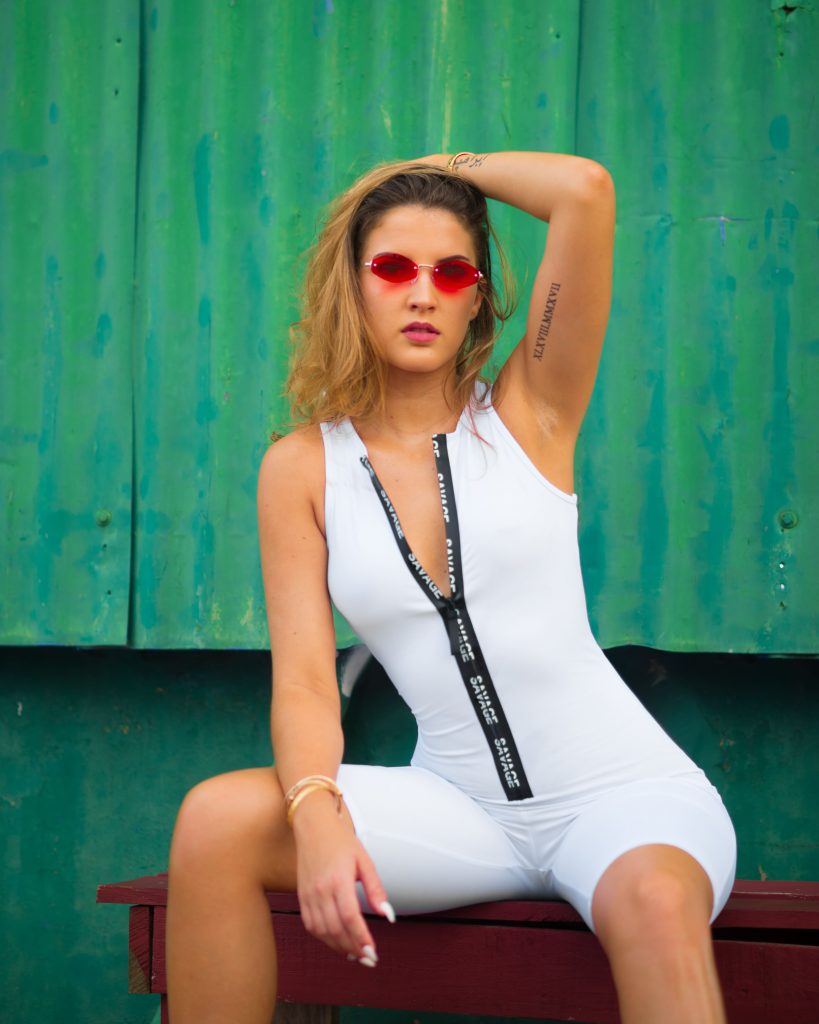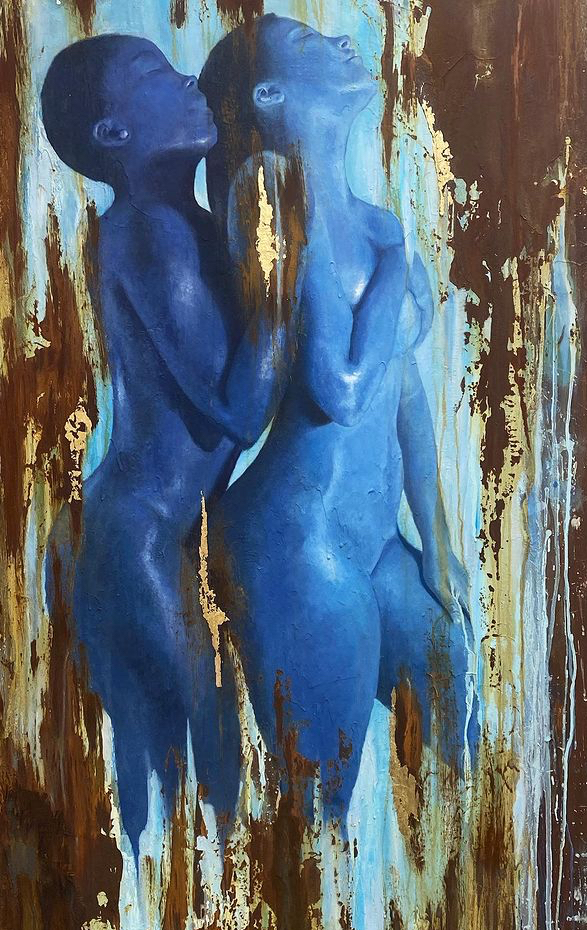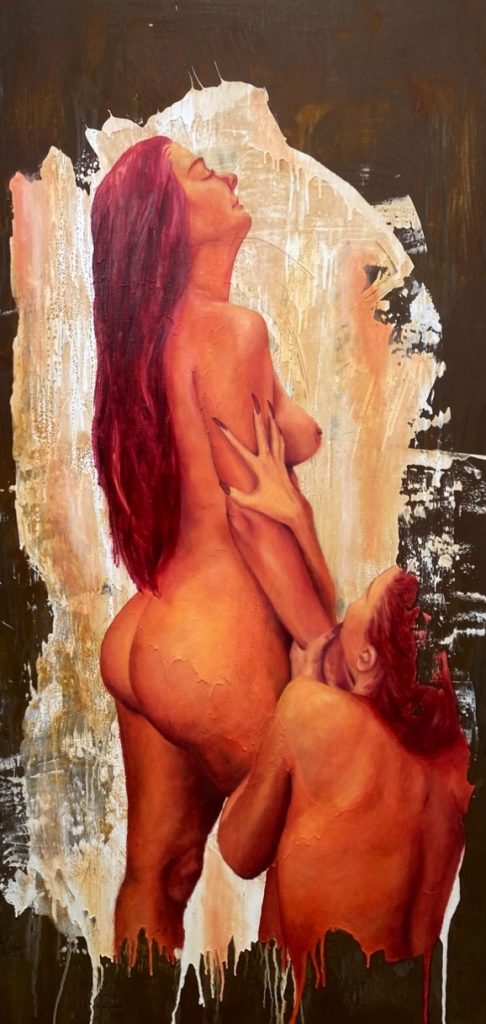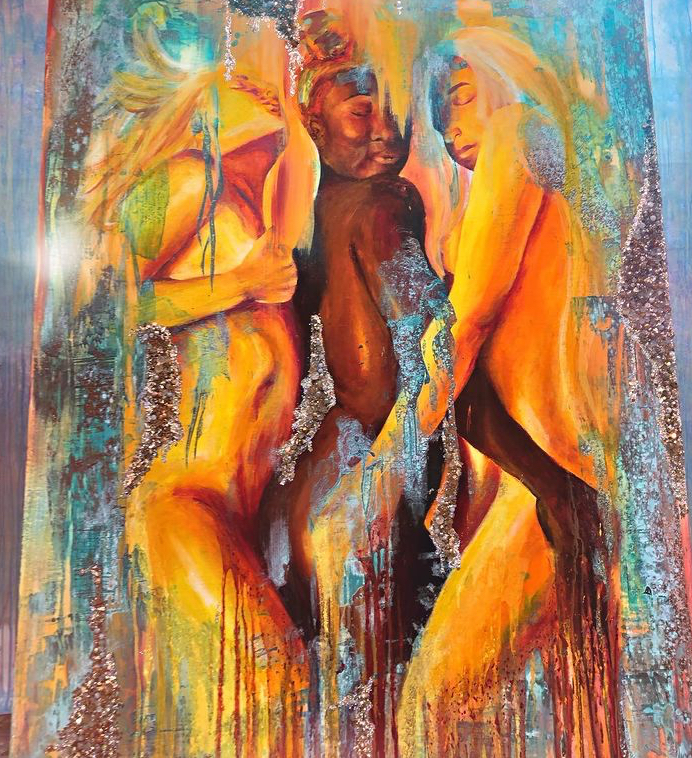Art plays an undeniable role in the socio-cultural evolution of our Caribbean society. As artists, we not only have a responsibility to depict our personal sentiments towards situations; we also have to address any form of systemic dysfunction in our society. The delicate balance of these two dynamics is what makes the calling of a true artist so unique and special, and Trinidadian visual artist Marie-Ange Pollonais has answered that call gracefully.
Marie-Ange Pollonais, a senior at the University of Tampa in Florida, is a mixed media artist who is currently pursuing a double major in Art & Graphic Design. Pollonais’ work as a graphic designer is undoubtedly intriguing, but it’s her paintings that have captured the hearts and minds of her Trinidadians both back home and across the diaspora. Every brilliant artist knows the value of having a good work flow and Pollonais is no different in that regard. For most of her paintings, she uses liquid iron as her base before oxidizing it on canvas. Her mesmeric use of color in her work is truly outstanding; but it is the thematic issues in her work why we esteem Pollonais a world-class, radical avant-garde artist.

The term “avant–garde” was originally a French term that was used to describe any means of creative expression that challenged the status quo of mainstream cultural values. The term was popularized during the modernist era of art history which stemmed from the 1900s to the 1960s. During that time period, avant-garde artists were divided into two categories: namely, ‘purist avant–garde’ and ‘radical avant–garde’. Radical avant–garde artists aimed to change society’s viewpoints on poignant cultural issues. It was considered as more ‘applied art’ with functional use that was oriented around making bold statements.
In a Caribbean society marred by homophobia and misplaced religious loyalty, it is valiant of Pollonais to use her art to empower the disenfranchised LGBTQ community. Her new series, ‘Love Is Magic’ , uses subtle nuances of homoeroticism to portray this community in a less vulgar and more sophisticated manner. Her artistic aim is to normalize love, sexuality and sensuality for every individual in the Caribbean as we grow in an increasing understanding that despite our differences, we are fundamentally all the same.

Though not apart of the LGTBQ community, Pollonais expressed empathy for its members, stating that: “It’s one thing to not agree with something but still be able to tolerate it; but it’s not okay to be scornful and condescending to people just because they are different. There is no issue in accepting that we all have different beliefs and opinions, but it’s unacceptable to put down others because of what they love, what they believe in and what they are.” Pollonais is unafraid to challenge the systemic homphobia in the Caribbean but she furthered her assertions by stating: “I wanted to open a window for the community within art and break social barriers.”
Pollonais is also very intentional about how she portrays homoerotic art, as she feels that some aspects of the way those bonds have been depicted are geared more towards vulgarity than artistry. “You will see a vulgar representation of alternative lifestyles in art with excessive nudity and genitals, but you rarely see anything about love and intimacy – so I wanted to challenge it because very few Caribbean artists paint on this topic; I want these relationships to be portrayed in a more meaningful way. Sometimes in the Caribbean, we treat members of the LGTBQ as if they are not human, not realizing that at our core we are all the same.”

Cultural retention is still important to Pollonais’ artistry and she takes ultimate pride in being a Caribbean woman. Ironically, she proclaims dancehall as her favorite genre of Caribbean music. The irony here is that dancehall has been internationally ostracized at times for its homophobic lyrical content. Pollonais acknowledges that this dynamic may have indeed been in the genre’s history, but expressed: “I love dancehall because it explores female sexuality in a beautiful way. When I am painting, I love listening to slow and sensual music because it gets me in a relaxed and sentimental mood. When I am painting, I tend to play music that will stimulate my sensual imagination so that I can express that in the art. My pieces are about partnership and sexuality and I feel like dancehall gives that to me.” Pollonais furthers her defense of the genre by highlighting how it gives a more holistic representation of a real relationship: “There’s songs about love and songs about sex. There are songs about cheating and even conflict in relationships, but I still find it soothing overall.”

Even though Pollonais addresses very sensitive issues in her art, she is still as light-hearted, dynamic and fun-loving as any Trinidadian woman can be. She shared a bit about her interest in sports, saying that : “I was recruited for Trinidad & Tobago’s youth football team when I was in high school, but I could never make it to the training sessions. All the sessions were in Town but I was from South, so it was difficult for me to find transportation to go (lol!)” Yoga is another one of her interests, but she told us without hesitation that art has and will always be her first love: “I’ve always enjoyed art, even since I was small. My mom was an art teacher and a drama teacher. We always had the tools for craft and building things, so I was brought up in a creative manner and an environment that was conducive to artistry. It was not only painting; we also did a bit of drawing as well, but I initially started learning the techniques of painting was when I was a freshman at the University of Tampa.”

We concluded our riveting conversation with Pollonais by engaging her on the general role she believes art plays in shaping the cultural identity of the Caribbean. It was no surprise that she had a plethora of positive closing remarks to share with us: “Art is definitely a tool for cultural ambassadorship. Look at carnival! Trinidad is the place for carnival and it turned into a humungous spectacle where everyone’s art is on display. Carnival is art in itself!” She furthered her point by highlighting the racial diversity of Trinidad & Tobago, stating that: “We are such an ethnically diverse people, and each ethnicity is represented artistically in some way; either through the culinary arts, our holidays and even in visual art . As visual artists in Trinidad, we take different things from each ethnicity. We get our brightness from African art; we get our detailed line work from Indian art; and we get use of watercolor paint or ink work from Chinese art. Art from Trinidad is so culturally diverse, but can still be more inclusive.”


